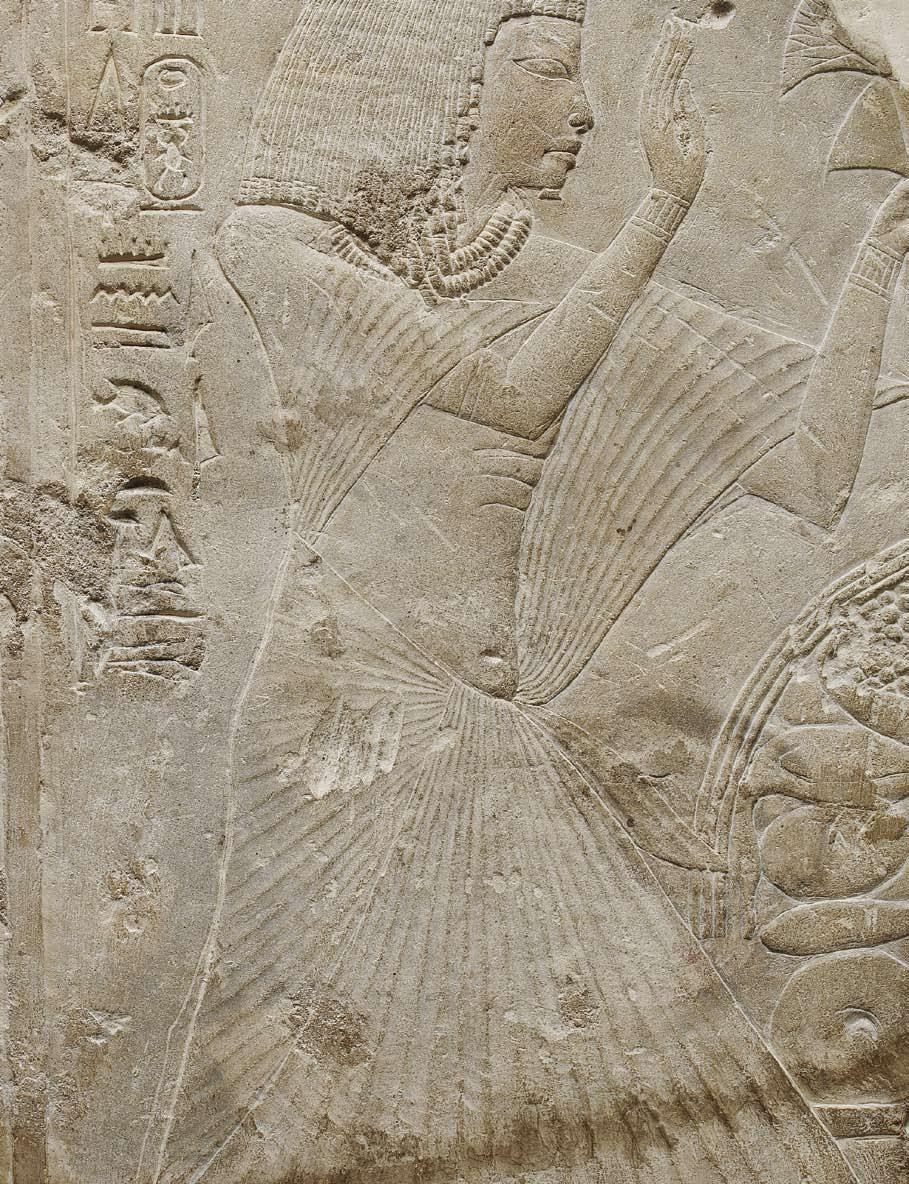

Th E h ISTO ry OF ANCIENT E G yp T
Ancient Egyptian civilisation was forged during the country’s long prehistoric phase. The Palaeolithic period was merely a regional phenomenon in that remote age from the history of mankind; the Mesolithic witnessed the development of societies featuring agile hunters who used bows and arrows and left paintings on the rocks in the bordering deserts; and the Neolithic innovations in crop-growing, in planting and weaving flax, and in the production of pottery. The Egyptian Neolithic is commonly believed to have started around 6000 BC, the date of a polished stone axe at the Museu Nacional de Arqueologia, Lisbon, brought from Egypt by José Leite de Vasconcelos. This very early period also produced the oval houses of Merimde Beni-Salame, in the West Delta, where the dead were buried in a foetal position inside the houses and facing east, where the sun rises (Araújo, 1993: 77-82).
This phase was followed by the Badari and Nagada cultures, which left countless remains, mainly in copper, ivory, pottery and stone. It was during this phase (4500-3000 BC) that the foundations for the civilisation of Ancient Egypt were laid. There are doubts as to the important political and cultural phenomenon of the country’s unification, and it is not known who actually achieved this feat. However, the southern ruler Narmer (who may be the Menes from the kinglists) is customarily identified as the first king of the unified nation, which combined upper and Lower Egypt. Clear signs of influence from the distant land of Mesopotamia are also known during this phase when the newly unified country emerged. These Sumerian influences, specifically from the Djemdet Nasr time (3100-3000 BC), are confirmed by brick buildings with palacestyle façades, by the taste for drawing mythological and composite animals (especially winged griffins and cats with snake-heads) found on palettes and knife-handles, and by the symmetrical group showing a bearded hero defeating two lions by crushing them in his arms. Pairs of entwined animals found on knife-handles and on the Narmer Palette demonstrate the existence of elements from Mesopotamia. Yet unlike Mesopotamia, where the leader was a representative of god, in Egypt he was considered to be a god in his own right.
At that time, the king of Egypt was a living Horus, a god on earth. Yet this divine vision of the king, the mainstay of the nation’s unity, had nothing to do with the west’s deeply-rooted and sometimes distorted Judaeo-Christian concepts of god. Rather, the king of Egypt should be seen as a figure with the broad cosmic and ritual functions that were typical of African royalty. The living Horuses who ruled in Ancient Egypt cannot be compared to the Judaeo-Christian god, who has a markedly creational and omnipotent aspect. The former were neither of these two things, at least in the cosmic sense, even though the king often bore the title iri-khet, or “maker of things”, applied to temples, tombs and monuments, and as a bringer of peace and harmonious prosperity. Thus, the living Horus was a human and divine being, the guardian of broad powers for good, the “dynamic centre of the universe, the being in which the cosmic and the social come together, a universal integrator”. In this sense, his remote origins lay in the divine African monarchies (Cervelló Autuori, 2001: 28-30). Egypt is indeed an African civilisation, and its language –formed over the centuries – is the result of the combined penetration of elements from Black
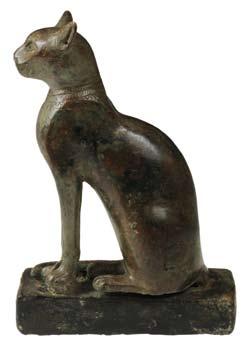
ties had employed and thus gaining supremacy over the Theban priests of Amun, although by that stage, they had already lost much of their former influence. Psamtek I also used the efficient services of Greek and Carian mercenaries to impose his rule, and tenaciously managed to overcome the internal and external difficulties. His name is inscribed on a limestone statuette in the Gulbenkian Collection that belonged to the senior official Bes (cat. no. 28).
The 26th dynasty, begun by Psamtek I (664-610 BC), was a period of prosperity that featured the revival of art (although this intentionally copied the art-forms from previous times), the revival of the Delta ’s cults and deities, the increase in zoolatry (sacred animals as hypostases of the gods), exemplified by the statuettes of cats (see nos. 29, 30 and 31) and the bull Apis (in the Egyptian collection at the Museu Nacional de Arqueologia), Greek influence, especially in the north, and the subordination of the recalcitrant priests of Amun to the power of the Saite monarchs (Lloyd, 2000: 369-394).
Psamtek I was succeeded by his son Nekau (610-595 BC), who wished to take steps in Northern Syria to prevent the advancing Chaldeans , but suffered a crushing defeat in Carchemish ( u pper Euphrates ). Evidently, Egyptian texts and monuments do not mention this failure, but it seems to have inspired a voyage to circumnavigate Africa from East to West. Sadly, there is no conclusive proof that this voyage took place. Psamtek II (595-589 BC) brought renewed interest in Nubia Egyptian forces invaded and – with the help of Greek and Carian soldiers – reached as far as the fourth cataract. The highpoint of the dynasty came under Apries (589-570 BC) and Ahmose (570-526 BC), when relations with the neighbouring Greek world were strengthened and the – a main centre for trade and cultural exchanges – was founded, including temples with Greek and Egyptian gods. As if to counter the growing Greek influence, a nationalistic reaction brought about repetition of artforms from Egypt’s glorious past.
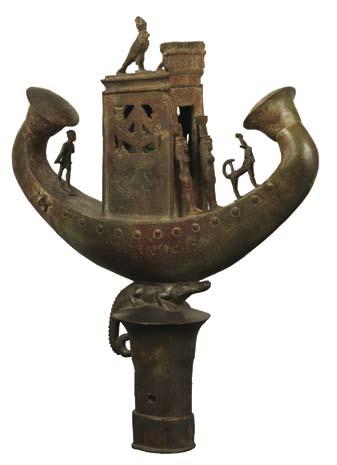
The Persian invasion under Cambyses at the start of the reign of Psamtek III brought the 26th dynasty to a close.The Persians conquered Egypt in 525 BC and turned the country into a satrapy within the great Achaemenid Empire. Some Egyptian officials also supported the new kings, who formed the 27th dynasty. under Darius I, the kingdom experienced a period of peace and major constructions, but Persian control became oppressive under Xerxes. Shortly after, the Achaemenids were expelled and Egypt started its last, ephemeral moment of independence under the 28th dynasty (with just one king called Amyrtaios, who expelled the Persians with the help of Greek troops), the 29th dynasty, based in Mendes (three kings) and the 30th dynasty (also with three kings). These last three dynasties were engaged in constant fighting against the Persians, and the conflict between Egypt and Persia was the regional form of the Greco-Persian rivalry that then afflicted the entire Eastern Mediterranean. The last Egyptian pharaoh dynasty was Nectanebo II, who disappeared under unknown circum, and in 343 BC, the Persians again took control of the country. This rule was, however, short-lived as the troops under Alexander the Great arrived in 332 BC. This revivalist last dynasty left significant works of art, including the beautiful
Statuette of a cat, Late Period (cat. no. 30).
gilded funerary mask (cat. no. 32) and the solar barque of Djedhor (cat. no. 33), from the Gulbenkian Collection.
The Greco-Roman period (332 BC-395 AD) started with the end of the Persian domination of Egypt and the arrival of the Greco-Macedonian conquerors under Alexander, who founded the new capital in Alexandria, in the West Delta . When the empire was divided up after Alexander ’s death in 323 BC, General Ptolemy became first the governor of Egypt and then king in 305 BC, establishing the Ptolemaic dynasty that was to reign for some threehundred years. The monarch was seen as an incarnation of two kings: one for the Greeks (the basileus ); the other for the Egyptians (the nesu-bit ), with the charisma of one or the other dominating according to circumstances (Sales, 2005: 307-308). Likewise, they had themselves portrayed in pharaonic poses, as clearly shown by the low-relief of a Ptolemaic ruler in the Collection (cat. no. 36).
Greek became the official language under the Ptolemaic dynasty, and the Greek influence in art, literature, the administration and military organisation continued throughout the next three hundred years, until the death of the famous Queen Cleopatra VII (30 BC).Yet even under Roman rule, the impact of Greek cultural influence was maintained. The Egyptians, the occupiers and many foreigners (namely Syrians) who moved to Egypt under the Roman Empire worshipped the traditional gods in large temples and crowded shrines, even though new deities had been introduced. The latter group included gods from the Greco-Roman pantheon, as demonstrated by the Collection’s fragmented statuette of Venus Anadiomene (cat. no. 40). The outstanding works of art from the Greco-Roman Period often adhered to the canons of Egyptian art, as again shown by several later objects from the Calouste Gulbenkian Collection (cat. nos. 34, 35, 37, 38 and 39).
At the request of the Ptolemaic dynasty which was then in power, the Romans gradually started to intervene in Egypt’s major internal issues, and they ultimately conquered it and turned the country of the Nile into a province of the Roman Empire, albeit one with a special status as it was directly subordinate to the emperor. Much of the wheat that supplied Rome flowed out of Egypt. The Greek cultural influence was maintained under Roman rule, and many buildings that are typical of the Greco-Roman world were built across Egypt, such as hippodromes, theatres and baths. Roman influence was felt in many aspects of Egyptian life, ranging from the manufacture of simple household tools to literature, art and religion. Several emperors appeared in the low-reliefs on temples (Edfu, Kom Ombo and Philae) and statues in the traditional pose of the pharaohs, some of whom had actually been to Egypt (Vespasian, Hadrian, Septimius Severus and Caracalla).
The Greco-Roman Period is habitually divided into three complementary phases: the Macedonian Dynasty, with Alexander and his direct successors (Philip Arrhidaeus and Alexander IV); the Ptolemaic Dynasty (305-30 BC); and the Roman Period (30 BC-395 AD). The GrecoMacedonian and Roman rulers generally enjoyed the more or less tacit support of the Egyptian priests and officials, many of whom noted the benefits of working with the authorities. One of those to co-operate was the priest Petosiris, from Hermopolis, who served Alexander and left some wise words on his tomb. These words, which could have been said by one of his educated predecessors from many centuries before, emphasising the importance of achieving maet, which encouraged the practice of justice and solidarity among men, read as follows: “The great reward for good is eternal life”.
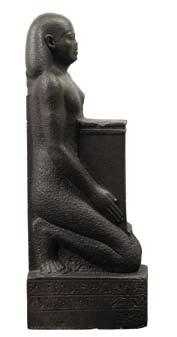
Statue of Djedhor, GrecoRoman Period (cat. no. 34).
Everything started in the long prehistoric phase of the Palaeolithic. Thanks to the finds made in Abasseia, Thebes-Waset, Kharga (Lower and Middle Palaeolithic), Kom Ombo and Faiyum (Lower Palaeolithic), among other areas, the well-known industry producing so-called Acheulean bifacial hand-axes and chipped-stone (Levallois-Mousterian) tools can be identified at a period between two million and thirty thousand years ago.
It is a short step from the rock paintings in Egypt’s desert borderlands (part of the broader field of Saharan pictorial art) and the production of pottery to the appearance of the Badarian and Naqada cultures. These later cultures left many copper and stone tools, geometrical palettes decorated with animal forms, stone and pottery jars with a variety of decorations and a range of adornments. Beautiful polished red pottery decorated with a yellowish-white colour reveals geometrical motifs on a red ground and a taste for the stylised depiction of animals and men, while many vessels called “black-topped jars” were also produced (present in the collections of the Museu da Farmácia and Museu Nacional de Arqueologia).
The unification of Egypt (circa 3000 BC) produced an outstanding work of art – the Narmer Palette – that had a significant political and cultural message. This schist plaque bears inscriptions on both sides and records the unification of the Two Lands, acting as a sort of birth certificate for Egypt. Since this work of art is fundamental in terms of understanding the iconography, themes, forms and ideology that would continue for a further three thousand years, I will briefly summarise previous studies (Araújo, 2001: 101-102). The famous Narmer Palette depicts a king with his symbols of power, standing in a dignified pose. His face is shown in profile, while his eyes are seen frontally, as is his chest. His trunk then turns until his legs are shown in profile, making the canonical movement of stepping forward with his left leg. Behind him is an official (in smaller scale), while the falcon Horus – representing the king himself – is in front of him. Two defeated, naked enemies in twisted poses and with no supporting base lie beneath him. The name of the monarch (Narmer) appears at the top, flanked by two cow-heads that represent the goddess Hathor. The unification of the country is recorded in hieroglyph script, which is also seen on the six papyruses in the image of his defeated enemy. Since each of the papyruses corresponds to six thousand, this states that Horus Narmer captured six thousand enemies. The reverse again bears the monarch’s name at the top, flanked by the protecting goddess Hathor. In this case, the king appears in the foreground, carrying a pear-shaped mace and the nekhakha sceptre (the symbol of Lower Egypt, which he captured), marching solemnly. His officials appear in smaller scale, and he is preceded by personifications of the four provinces that helped in his campaign as he advances on a group of ten decapitated enemies. The central section shows two mythological animals held firmly by two men. As these beasts are based on Mesopotamian models, they demonstrate the Sumerian influence that can be observed when unified Egypt emerged. The lower section contains the image of a bull (the king) using his powerful horns to knock down the walls of an enemy city while simultaneously treading on his defeated adversary.
The Narmer Palette reveals some of the canons of Egyptian figurative art that would survive for many centuries and that are superbly documented by the objects in exhibition at the Calouste Gulbenkian Museum. These include an evident appreciation of the quest for balance and the almost obsessive desire for symmetrical forms; the insistence on depicting animals, which were largely seen as manifestations of power or hypostases of the deities; the interplay of proportions, where different sizes appeared according to the importance of the person portrayed; the clear preference for “aspective” depiction of things; the compulsory line at the base to support the

figures; the use of a symbolism associated to exercising power, with crowns, sceptres, attire and other insignia. On one side, the king is wearing the white crown of upper Egypt, while he has the red crown Lower Egypt on the other, as well as a bull’s tail around his waist and the divine mace. The pointed contrast between the dignified, hieratic pose of the Egyptians and the twisted, unsupported pose of the enemy, who are portrayed as expressions of chaos, is also of note.
This famous palette is just one example of the production of countless objects from the proto-historical period found in the collections of some Portuguese museums, particularly the various pottery vessels and zoomorphic and geometrical palettes at the Museu da Farmácia and the Museu Nacional de Arqueologia.
Funerary constructions developed under the 1st (Thinite) dynasty, and large brick tombs with wooden beams were built in Abydos and Saqqara. This involved the underground image of the royal palace designed for eternity, while such tombs also extended to senior officials who also had their palaces for eternity (per-djet).
Egyptian architecture’s specific forms make it instantly recognisable. It cannot be confused with the building work produced in other civilisations, and essentially reveals the religious nature of its tombs and temples. The early royal tombs, built between 3100 and 3000 BC, have an interrupted brick wall, adopting a Mesopotamian-influenced style that is normally called “palace façade”, while other influences of the same sort also appeared, such as the cylinder seals and thematic motifs on decorating objects. Archaic architecture particularly features tombs in the typical mastaba form, built in large royal necropolises in Saqqara (for the king’s body) and Abydos (for his viscera).
Egyptian tombs are normally divided into two parts: the private area holding the mummified body of the deceased and his goods for use in eternity; and the public space, where family members and priests (the priests of the ka) from the funerary cult would go. Mastabas originally
The Narmer Palette: on one side, the king wearing the crown of Upper Egypt, on the other, wearing the crown of Lower Egypt Egyptian Museum, Cairo
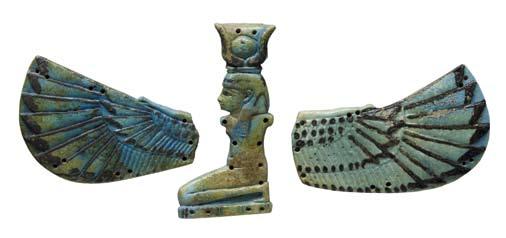
the 30th dynasty did show some dynamism in building work, this was ultimately nothing more than an initial effort for work that would undergo future development in the Ptolemaic Period.
Sculpture from this period shows an obstinate return to the past, revealing the search for the sober classicism of Memphis in the Old Kingdom and for some inspiration from Middle Kingdom and New Kingdom work. under the 26th dynasty and the celebrated “Saite renaissance”, the statues of kings, other individuals and deities were all designed to create balanced forms. The most striking feature is the technical sophistication in polishing the stone. However, the name “Saite renaissance” can be challenged, as numerous pieces that are believed to be original are in fact the result of continuous evolution since the 25th dynasty. This “renaissance” would continue to be felt in the last Egyptian dynasty before the definitive loss of independence, as the 30th dynasty (whose last king was Nectanebo II) produced some fine works of sculpture that already showed strongly idealised features.
Thousands of the bronze statuettes that are commonly found in Egyptian collections date from the Late Period. These mainly show the main gods who were then worshipped: the famous triad of OsIrys, Isis and Horus, Tot, Ptah, Bes, Min, Anubis, the goddesses Bastet and Neit, and the bull Apis, among others. The Museu Nacional de Arqueologia has examples showing these gods, and such statuettes were still being produced in large quantities during the Greco-Roman Period, alongside others made in terracotta. It is symptomatic of the new age that the depiction of Amun, once so common, practically disappeared.
The production of sarcophagi, funerary masks, canopic jars, scarabs and amulets continued to fuel a prospering industry that served the afterlife, but few of these pieces can compete with the exceptional work from previous eras. Special reference can be made to the wooden sarcophagi with hieroglyph texts using signs in various colours and incrusted materials, as well as the heavy coffins in exceptionally hard stones that preserved the mummies of some senior officials from both the Saite period and later ages.
Despite losing its political independence, Egypt maintained exceptional cultural autonomy, as clearly shown by its art, especially the imposing architecture. The large and now well-preserved temples in Edfu, Kom Ombo and Philae, which date from the last three hundred years of the first millennium, continued the architectural traditions from the time when Egypt was a powerful country whose culture spread to and influenced its neighbours. Even in the Christian era, under Roman rule, construction work continued and some temples were completed. One of the novel-
Funerary adornment with the winged goddess Isis, Late Period (cat. no. 20).
ties of the age was the construction of walls between the columns, closing and further isolating the sacred space and creating more areas for decoration. Another was the appearance of composite plant-motif capitals decorated with complex foliage, as demonstrated by one of the most characteristic works in Philae’s architecture: the pavilion or shrine of Trajan, which dates from (98117), although it should be attributed to Augustus. In this case, the unfinished decorative programme recalls the peripteral buildings of the Middle and New Kingdoms. Although few in number, the surviving pieces of private funerary architecture from the Greco-Roman Period are superbly exemplified by shrines shaped like small temples, such as the tomb of PetosIrys in Tuna el-Gebel, whose internal decoration is also a model for the syncretic tastes of the age. PetosIrys’ wooden sarcophagus, now at the Egyptian Museum in Cairo (Bongioanni & Croce, 2001: 253), is equally eloquent in terms of demonstrating the preference for maintaining an ancient iconography, as it features fine incrusted hieroglyphs.
The production of sarcophagi included large rectangular stone urns and anthropomorphic stone coffins, especially typical of the Late Period. This would continue during the Greco-Roman Period. However, most sarcophagi were made of wood or cartonnage, and involved abundant decoration, protecting the mummified body and its funerary mask, which was often gilded. Although the Gulbenkian Collection has no such sarcophagi, they can be found in Portugal at the Museu Arqueológico do Carmo, the Museu de História Natural of the Oporto’s Faculty of Science, the Museu da Farmácia, the Museu Nacional de Arqueologia (one in wood, the other in cartonnage) and the Sociedade de Geografia de Lisboa (five from the 21st dynasty, and three inner coffin lids for mummies).
Sculpture also fundamentally followed the norms and models of the Late Period, depicting the Ptolemaic kings and Roman emperors in the pharaonic style and using the traditional iconography (Ibidem: 252). Other individuals, especially senior Egyptian officials working for the Ptolemaic administration, benefited from the work of the royal workshops and commissioned statues, while craftsmen continued to produce high quality adornments.The end of the Gulbenkian Collection’s exhibition has fine examples of the variety and quality of Egyptian art from its final phase. The pieces in question are the basalt statue made for Djedhor (cat. no. 34), the model of a sphinx (cat. no. 35), returning to a traditional form of representing royal power that dates back to the Old Kingdom, a delicate low-relief which is a study for a pharaoh’s head (cat. no. 36), the silver figure of Harpocrates (the child Horus who was so widely worshipped at the time: cat. no. 37), and a fluted breccia bowl (cat. no. 38) that – many centuries on – still bears witness to continued mastery in the art of creating vessels in hard stones, a skill that had developed in the distant prepharaonic times. The Ptolemaic Period also produced such exceptional works as the green schist head of an official (cat. no. 39), a highly realistic piece that appears to bear all the characteristics of a genuine portrait. The exhibition ends in chronological terms with a piece from the Roman Period: the torso of a statuette of Venus Anadiomene. Made in blue faience, the modelling and movement reveal enormous differences from works of art produced in previous eras.
It can be concluded that there was a clear continuity of forms over the millennia of pharaonic civilisation. Comparison between the themes and techniques used to produce objects in the Archaic Period and in the Late Period reveals that little or nothing had changed in many cases. Clearly, there are differences, new tastes and adaptations, but the idea of continuity and permanence is immediate and evident, as superbly illustrated by the collection assembled by Calouste Gulbenkian

Sarcophagus of the Lady Irtierut, Late Period Museu da Farmácia, Lisbon
